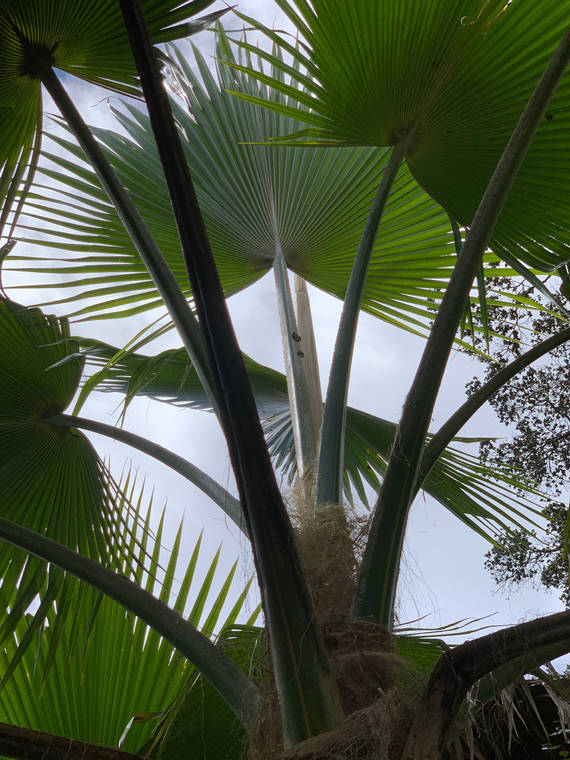Tropical Gardening: Hawaii’s native forests threatened

Courtesy of VOLTAIRE MOISE More than two dozen endemic Pritchardia palms (loulu), found no other place on Earth, are on the verge of extinction because of rats and pigs. We can help avoid this if we plant them in our parks and gardens.
Like so much of the tropical world, the forests of Hawaii’s coastal and mountain regions are under assault.
Like so much of the tropical world, the forests of Hawaii’s coastal and mountain regions are under assault.
Through the years, we have seen massive timber clearing for pasture and sugarcane. Now, thousands of acres were abandoned and are being naturally reforested with non-native species. These trees are sometimes called weeds, but remember that they are pioneer species attempting to heal the wounds created by nature and human activities.
ADVERTISING
When it comes to native forests, large portions of our island have been protected in national parks and state forest watersheds. Unfortunately, these, too, are under assault by nature. Global warming along with new diseases such as rapid ohia death and koa wilt are killing some of our most revered trees.
The natural world seldom stays the same, as we are reminded by COVID-19. We can attempt to control nature by minimizing the introduction of insects and diseases. We can avoid introducing plant or animal species that might have a negative effect on our native forests.
Climate change is having a tremendous impact. As temperatures rise, high elevations are being invaded by mosquitos thus threatening our endemic birds with disease. Global warming will affect much of the tropics, including our islands, by causing more extremes such as drought, flooding and severe storms.
We might not be able to do much about other parts of the world, but here at home we as individuals are either part of the solution or part of the problem. Cutting down trees is a step in the wrong direction. Planting trees is a step in the right direction. That can make a big difference, since trees not only produce oxygen, they supply shade, act as windbreaks and lock up the carbon that is the main cause of global warming.
In East Hawaii, many forest areas are subdivided into small lots of 1-3 acres. Unless the owners of the land really commit to protecting the forested lots, they are bulldozed and flattened. In West Hawaii, much of our uplands are still covered with native forest.
Where our family lives in Kaloko Mauka, it is sparsely populated, and the gardens are a fascinating mixture of hydrangeas, hoawa, calatheas, camellias, koa, kopiko and many other natives. The area abounds with ancient ohia (Meterosideros polymorpha) and gigantic tree ferns.
The native forest contains many rare and endangered species residents are committed to protect through the county Tax Department that allows residents to dedicate their land to forest, protecting this important and unique watershed. This region between 2,000 and 5,000 feet in elevation is actually cloud forest. Up to 40% of the precipitation comes from the mists that abounds. When the cloud forest is cleared, the area dries.
The cloud forests of Kaloko Mauka are the home of the Hawaiian hawk, apapane, iiwi, elepaio, amakihi and many other endemic and exotic birds. Kaloko Mauka was identified as essential wildlife habitat and forest watershed. This is essential if our island is to have the rainfall and watershed needed to supply communities at lower elevations.
Some folks think East Hawaii has plenty of rain, so forests are not necessary. However, forests are like big sponges. They slow down flooding rains and give up moisture so streams continue to run when rainfall is light. Without forests, flooding and drought as well as severe erosion become the norm. Also, grasslands are infamous fire hazards during drought times.
Tropical forests include not only trees but understory palms, orchids and ferns. Many plants such as our endemic Pritchardia palms are endangered because pf the destruction of the forests.
Fortunately, Hawaii is becoming a kind of ark for rare plants thanks to the efforts of the Hawaii Island Palm Society, Bamboo Society, Sierra Club, Nature Conservancy, Outdoor Circle, Moku o Keawe, Hawaii Island Land Trust and other concerned groups.
Remember, not only is it vital to protect our remaining Hawaiian forests, but to reforest those abandoned cane lands thus ensuring valuable forest resources for future generations.
For more information about forest planting and management, contact UH Extension forester J.B. Friday at 959-9155 when the COVID lockdown is pau.


